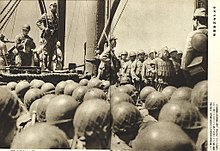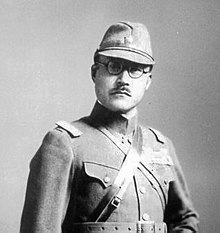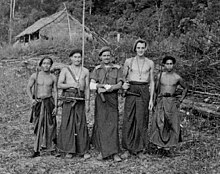Japanese occupation of British Borneo
[16] In 1940 the Americans and British had placed an embargo on exports of raw materials to Japan because of its continuing aggression in China and the Japanese invasion of French Indochina.[17][18][19][20] Chronically short of natural resources, Japan needed an assured supply, particularly of oil, in order to achieve its long-term goal of becoming the major power in the Pacific region.The Brigade was led by Major General Kiyotake Kawaguchi and consisted of units previously stationed at Canton in southern China.The convoy proceeded without being detected and, at dawn on 16 December, two landing units secured Miri and Seria with little resistance from British forces.[25][28] On 22 December, Brunei Town was captured and the main Japanese force moved westwards towards Kuching after securing the oilfields in northern Sarawak.After escorts drove off a lone Dutch submarine, the Japanese task force entered the mouth of the Santubong River on 23 December.[28] The convoy, including twenty transports carrying Japanese troops commanded by Colonel Akinosuke Oka, arrived off Cape Sipang and had completed disembarkation by the next morning.On 31 December a force under Lieutenant Colonel Genzo Watanabe moved northward to occupy the remainder of Brunei, Beaufort and Jesselton.[30] Ethnocentrism was central to this plan with Japanese values, world view, culture, spirit, emperor worship and racial superiority being promulgated.The impact of the war on native livelihood should be alleviated where possible and within the limits set by the need for rendering occupational forces self-sufficient and securing resources vital to national defence.[33]Attempts were also made to inculcate anti-Western feeling with local government officers required to attend Japanese night classes.Unlike his counterparts in North Borneo and Sarawak which were previously ruled by European officials, the Brunei Sultan, Ahmad Tajuddin, was retained by the Japanese with no reduction in salary.Maeda was killed along with Major Hataichi Usui and Pilot-Captain Katsutaro Ano in an air crash while flying to Labuan Island on 5 September 1942.Yamawaki was formerly Director of the Resources Mobilisation Bureau; his appointment in 1942 was interpreted by the Allies as part of a drive to establish Borneo as a significant location for storage of supplies and the development of supporting industry.[46] Due to this, the Japanese planned to construct a total of twelve airfields in different parts of northern Borneo to strengthen its defence, of which seven were to be located in Api, Elopura, Keningau, Kudat, Tawau, Labuan and Lahad Datu.In total the Japanese are believed to have held an estimated 4,660 prisoners and internees at all camps in northern Borneo, with only 1,393 surviving to end of the war.[31] The Japanese particularly exploited the Chinese community, mainly due to their support for the Kuomintang and contributions to the China Relief Fund and British war efforts.In response to a directive from Singapore in 1942, the poor treatment of indigenous people began to be alleviated as they were not perceived to be the main enemies of Japan.[33] With the sparse and widely dispersed local population in northern Borneo, the Japanese military administration had little choice but to rely on forced labour from abroad, mainly from elsewhere in the Dutch East Indies and occupied China, under the management of the North Borneo Labour Business Society (Kita Boruneo Romukyokai).[63] As both Korea and Taiwan had been under the domination of Japan for decades, many citizens of both territories were forced to work for the Japanese military under harsh conditions.[64] On the west coast of North Borneo, a resistance movement developed led by Albert Kwok, a Chinese from Kuching, who after working with the China Red Cross moved to Jesselton in 1940.[68] Though they were poorly equipped, the attack still managed to kill at least 50 Japanese soldiers and temporarily capture Api, Tuaran and Kota Belud in early November.[82] The 24th Infantry Brigade, part of the 9th Division, landed at the southern end of Labuan, near the entrance of Brunei Bay, and commanding the approach to northern Borneo.The 24th Infantry Brigade encountered stronger opposition in taking Labuan,[81] where the defenders withdrew to an inland stronghold and held out among dense jungle-covered ridges and muddy swamps.To subdue the Japanese resistance an intense naval and artillery bombardment was laid down over the course of a week before an assault was put in by two companies of infantry supported by tanks and flamethrowers.[84] The 2/32nd Battalion landed at Padas Bay and seized the town of Weston before sending out patrols towards Beaufort, 23 kilometres (14 mi) inland.[97] The British Military Administration (BMA) took over the task of management from the Australians on 12 September 1945 and summarised the situation towards the end of October: In North Borneo and Labuan the destruction of coastal townships was almost total, and in Brunei the shop quarter and many Government buildings were completely destroyed.[100] Lieutenant Colonel Tatsuji Suga, who had been responsible for the Batu Lintang camp administration, believing that his entire family had been killed during the US atomic bombing of Hiroshima committed suicide before his trial's conclusion.[14] Captain Susumi Hoshijima, who was responsible for the administration of Sandakan camp, was found guilty of war crimes and hanged in Rabaul, New Guinea in 1946.[109] The Petagas War Memorial garden is built on the site where hundreds of people, including women and children, were massacred by the Japanese.














West MalaysiaJapanese occupation of MalayaJapaneseFlag of the Empire of JapanImperial SealHakkō IchiuKimigayoMilitary occupationEmpire of JapanKuchingChineseBornean languagesEmperorShōwaKiyotake KawaguchiToshinari MaedaMasao BabaWorld War IIPacific WarJapanese troops landBritish troopsAllied liberationBorneoSurrender of JapanBritish Military AdministrationJapanese-issued dollar ("Banana money")Raj of SarawakBruneiNorth BorneoCrown Colony of LabuanBritish Military Administration (Borneo)MalaysiaSarawakLabuanBritish North BorneoDutch East IndiesCam Ranh BayFrench IndochinaJapanese navyJapanisationJapanese languageprisoner of war campsAustralian commandosUS submarinesZ Special Unitindigenous peopleguerrilla warfareBorneo CampaignGreater East Asia Co-Prosperity SphereHachirō AritaMinister for Foreign AffairsJapanese EmpireMonroe DoctrineSumatraMalayaCelebesAmerican-British-Dutch-Australian CommandAnglo-Japanese AllianceMitsubishiNissanred-light districttelegramsJesseltonembargoaggression in ChinaJapanese invasion of French IndochinaSoutheast AsiaEuropean coloniesWestern colonialism periodBattle of Borneo (1941–42)2nd Yokosuka Naval Landing ForceImperial Japanese ArmyImperial Japanese Navy35th Infantry BrigadeCantonMurakumoShinonomeShirakumoUsugumoKamikawa MaruTakeo KuritaKumanoSuzuyaFubukiSagiriKuala BelaitLutongBrunei TownSingkawangAkinosuke Oka15th Punjab RegimentAlliedSampitBeaufortSandakanCharles Robert SmithJapanese propagandaJawi scriptMalay languageJapanese troopsAsahi ShimbunMainichi ShimbunCelebes IslandJapanese governmentPropagandaEthnocentrismJapanese valuesworld viewJapanese national anthemJapanese flagChinese immigrantsanti-Western feelingAhmad TajuddinPontianakNatuna IslandsKota BeludKota MaruduKeningauWestonElopuraBeluranLahad DatuprefecturesMarquisKawaguchi DetachmentMarquess